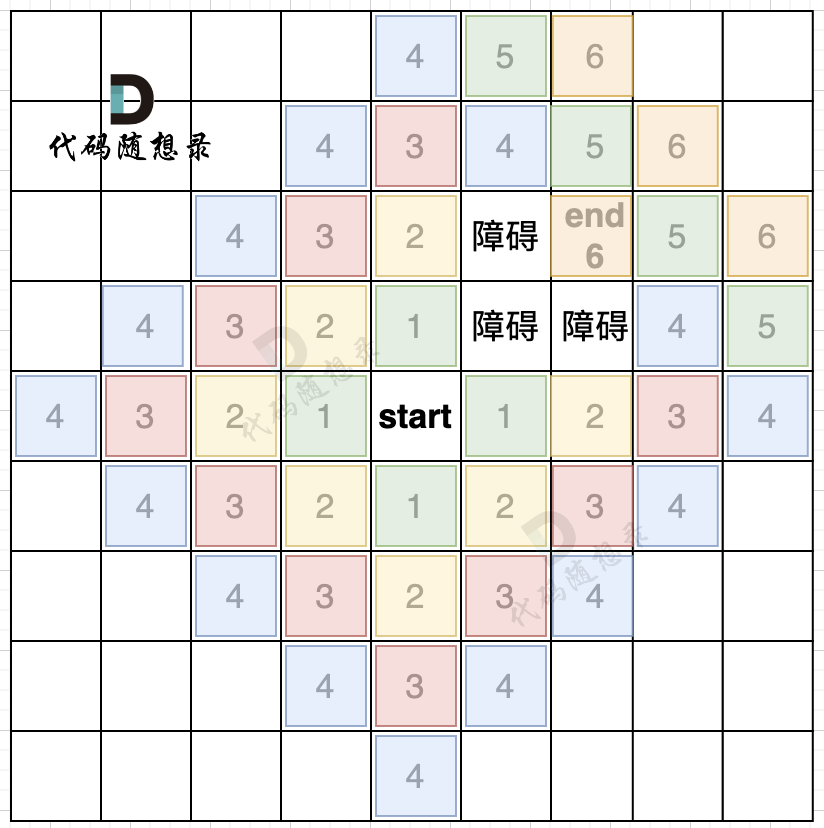习题1
分别以邻接矩阵和邻接表作为存储结构,实现以下图的基本操作:
①增加一个新顶点v, InsertVex(G, v);
②删除顶点v及其相关的边,DeleteVex(G,v);
③增加一条边<v, w>, InsertArc(G, v, w);
④删除一条边<v, w>, DeleteArc(G, v, w)。
以邻接矩阵作为存储结构(有向图)
#include <stdio.h>
#include <stdlib.h>#define MaxInt 32767
#define MVNum 100typedef char VerTexType;
typedef int ArcType;typedef struct
{VerTexType vexs[MVNum];ArcType arcs[MVNum][MVNum];int vexnum;int arcnum;
}AMGraph;void CreateDG(AMGraph& G);
int LocateVex(AMGraph& G, VerTexType v);
void printfAMGraph(AMGraph& G);
void InsertVex(AMGraph& G, VerTexType v);
void DeleteVex(AMGraph& G, VerTexType v);
void InsertArc(AMGraph& G, VerTexType v, VerTexType w);
void DeleteArc(AMGraph& G, VerTexType v, VerTexType w);int main()
{AMGraph G = { {'\0'}, {0}, 0, 0 };CreateDG(G);printfAMGraph(G);printf("\n\n增加一个点'5'后:\n");InsertVex(G, '5');printfAMGraph(G);printf("\n\n删除一个点'4'后:\n");DeleteVex(G, '4');printfAMGraph(G);printf("\n\n增加一条弧<5,2>后:\n");InsertArc(G, '5', '2');printfAMGraph(G);printf("\n\n删除一条弧<5,2>后:\n");DeleteArc(G, '5', '2');printfAMGraph(G);return 0;
}//采用邻接矩阵表示法创建有向图
void CreateDG(AMGraph& G)
{int i = 0;int j = 0;int k = 0;VerTexType v1 = '\0';VerTexType v2 = '\0';ArcType w = 0;printf("请输入有向图的总顶点数:");scanf_s(" %d", &G.vexnum);printf("请输入有向图的总边数:");scanf_s(" %d", &G.arcnum);for (i = 0; i < G.vexnum; ++i){printf("请输入第%d个顶点储存的元素:", i + 1);scanf_s(" %c", &G.vexs[i], sizeof(VerTexType));}//初始化邻接矩阵,将边的权值均置为0for (i = 0; i < G.vexnum; ++i){for (j = 0; j < G.vexnum; ++j){G.arcs[i][j] = 0;}}//构造邻接矩阵for (k = 0; k < G.arcnum; ++k){printf("请输入第%d条边依附的两个顶点(用空格间隔,输入结束后按回车) : ", k + 1);scanf_s(" %c %c", &v1, sizeof(VerTexType), &v2, sizeof(VerTexType));i = LocateVex(G, v1);j = LocateVex(G, v2);G.arcs[i][j] = 1;}
}//在G的顶点表vexs中获取字符v的下标(数组G.vexs的下标从0开始)
int LocateVex(AMGraph& G, VerTexType v)
{int i = 0;for (i = 0; i < G.vexnum && (G.vexs[i] != v); ++i){;}return i;
}//打印邻接矩阵表示法中的顶点表vexs和邻接矩阵arcs
void printfAMGraph(AMGraph& G)
{int i = 0;int j = 0;printf("各顶点为:");for (i = 0; i < G.vexnum; i++){printf("%c ", G.vexs[i]);}printf("\n邻接矩阵为:\n");for (i = 0; i < G.vexnum; i++){for (j = 0; j < G.vexnum; j++){if (G.arcs[i][j] == 32767){printf("%d ", G.arcs[i][j]);}else{printf("%d ", G.arcs[i][j]);}}printf("\n");}
}//增加一个新顶点v, InsertVex(G, v)
void InsertVex(AMGraph &G, VerTexType v)
{G.vexs[G.vexnum] = v;G.vexnum++;
}//删除顶点v及其相关的边,DeleteVex(G, v)
void DeleteVex(AMGraph& G, VerTexType v)
{int k = 0;k = LocateVex(G, v);int i = 0;int j = 0;int m = k;//从第k+2个元素起,数组vexs中的每一个元素都向前移动一个for (i = k+1,m = k; i < G.vexnum; i++,m++){G.vexs[m] = G.vexs[i];}//从第k+1行起,邻接矩阵中的每一行都向上移一行for (i = k + 1, m = k; i < G.vexnum; i++,m++){for (j = 0; j < G.vexnum; j++){G.arcs[m][j] = G.arcs[i][j];}}//从第k+1列起,邻接矩阵中的每一行都向前移一列for (j = k + 1, m = k; j < G.vexnum; j++, m++){for (i = 0; i < G.vexnum; i++){G.arcs[i][m] = G.arcs[i][j];}}//最后一行全部变为0for (i = 0; i < G.vexnum; i++){G.arcs[G.vexnum - 1][i] = 0;}//最后一列全部变为0for (i = 0; i < G.vexnum; i++){G.arcs[i][G.vexnum - 1] = 0;}G.vexnum--;
}//增加一条边<v, w>, InsertArc(G, v, w);
void InsertArc(AMGraph &G, VerTexType v, VerTexType w)
{int i = LocateVex(G, v);int j = LocateVex(G, w);G.arcs[i][j] = 1;G.arcnum++;
}//删除一条边<v, w>, DeleteArc(G, v, w)。
void DeleteArc(AMGraph &G, VerTexType v, VerTexType w)
{int i = LocateVex(G, v);int j = LocateVex(G, w);G.arcs[i][j] = 0;G.arcnum--;
}


以邻接表作为存储结构(无向图)
#include <stdio.h>
#include <stdlib.h>#define MVNum 100typedef int OtherInfo; //假设在边结点中的数据域存储边的权值,且边的权值类型为整型
typedef char VerTexType; //假设顶点的数据类型为字符型typedef struct ArcNode
{int adjvex;struct ArcNode* nextarc;OtherInfo info;
}ArcNode; //边结点typedef struct VNode
{VerTexType data;ArcNode* firstarc;
}VNode, AdjList[MVNum]; //表头结点typedef struct
{AdjList vertices; //存储所有顶点int vexnum; //顶点总数int arcnum; //总边数
}ALGraph; //图的信息void CreateUDG(ALGraph& G);
int LocateVex(ALGraph& G, VerTexType v);
void printALGraph(ALGraph& G);
void InsertVex(ALGraph& G, VerTexType v);
void DeleteVex(ALGraph& G, VerTexType v);
void InsertArc(ALGraph& G, VerTexType v, VerTexType w);
void DeleteArc(ALGraph& G, VerTexType v, VerTexType w);int main()
{ALGraph G = { {'\0',NULL}, 0,0 };CreateUDG(G);printALGraph(G);printf("\n\n\n增加一个点'6'后:\n");InsertVex(G, '6');printALGraph(G);printf("\n\n\n删除一个点'4'后:\n");DeleteVex(G, '4');printALGraph(G);printf("\n\n\n增加一条边(6,2)后:\n");InsertArc(G, '6', '2');printALGraph(G);printf("\n\n\n删除一条边(6,2)后:\n");DeleteArc(G, '6', '2');printALGraph(G);return 0;
}void CreateUDG(ALGraph& G)
{int i = 0;int k = 0;VerTexType v1 = 0;VerTexType v2 = 0;int j = 0;ArcNode* p1 = NULL;ArcNode* p2 = NULL;printf("请输入无向图的总顶点数:");scanf_s(" %d", &G.vexnum);printf("请输入无向图的总边数:");scanf_s(" %d", &G.arcnum);for (i = 0; i < G.vexnum; ++i){printf("请输入第%d个顶点的值:", i + 1);scanf_s(" %c", &(G.vertices[i].data));G.vertices[i].firstarc = NULL; //初始化}for (k = 0; k < G.arcnum; k++){printf("请输入第%d条边依附的两个顶点(用空格间隔,输入结束后按回车): ", k + 1);scanf_s(" %c %c", &v1, sizeof(VerTexType), &v2, sizeof(VerTexType));i = LocateVex(G, v1);j = LocateVex(G, v2);p1 = (ArcNode*)malloc(sizeof(ArcNode));p1->adjvex = j;p1->nextarc = G.vertices[i].firstarc;G.vertices[i].firstarc = p1; //将新结点*p1插入顶点Vi的边表头部p2 = (ArcNode*)malloc(sizeof(ArcNode));p2->adjvex = i;p2->nextarc = G.vertices[j].firstarc;G.vertices[j].firstarc = p2; //将与*p1对称的新的边结点*p2插入顶点Vj的边表头部}
}//在G的顶点表vexs中获取字符v的下标(数组G.vexs的下标从0开始)
int LocateVex(ALGraph& G, VerTexType v)
{int i = 0;for (i = 0; i < G.vexnum && (G.vertices[i].data != v); ++i){;}return i;
}//打印邻接表
void printALGraph(ALGraph& G)
{int i = 0;ArcNode* pMove = NULL;for (i = 0; i < G.vexnum; i++){printf("\n第%d个顶点为:%c", i + 1, G.vertices[i].data);pMove = G.vertices[i].firstarc;if (pMove){printf("\n与第%d个顶点相邻接的每个顶点为:", i + 1);while (pMove){printf("%c ",G.vertices[pMove->adjvex].data);pMove = pMove->nextarc;}}else{printf("\n没有与第%d个顶点相邻接的顶点。", i + 1);}}
}//增加一个新顶点v, InsertVex(G, v)
void InsertVex(ALGraph&G, VerTexType v)
{G.vertices[G.vexnum].data = v;G.vertices[G.vexnum].firstarc = NULL;G.vexnum++;
}//删除顶点v及其相关的边,DeleteVex(G, v)
void DeleteVex(ALGraph& G, VerTexType v)
{int i = 0;int j = 0;int k = 0;int m = 0;ArcNode* p = NULL;int num = 0;k = LocateVex(G, v);for (i = 0; i < G.vexnum; i++){p = G.vertices[i].firstarc;if (i != k && p){if (p && p->adjvex == k){G.vertices[i].firstarc = p->nextarc;free(p);p = NULL;}else{ArcNode* Pre = p;while (p && p->adjvex != k){Pre = p;p = p->nextarc;}if (!p){continue;}else{Pre->nextarc = p->nextarc;free(p);p = NULL;}}}if (i == k){while (p){ArcNode* temp = p;p = p->nextarc;free(temp);temp = NULL;}}}G.vexnum--;//从第k+2个元素起,数组vexs中的每一个元素都向前移动一个for (i = k; i < G.vexnum; i++){G.vertices[i]= G.vertices[i+1];}// 清空数组vexs中最后一个顶点的信息G.vertices[G.vexnum].data = '\0';G.vertices[G.vexnum].firstarc = NULL;//更新所有边表中的顶点索引/* 删除顶点后,顶点数组中的顶点被向前移动了一位,这意味着比被删除顶点索引高的顶点的索引都减少了 1。否则,它们会仍然指向旧的索引位置及顶点值。*/for (i = 0; i < G.vexnum; i++){p = G.vertices[i].firstarc;while (p){if (p->adjvex > k)p->adjvex--; // 如果该边指向的顶点索引大于k,则减1p = p->nextarc;}}
}//增加一条边(v, w), InsertArc(G, v, w);
void InsertArc(ALGraph& G, VerTexType v, VerTexType w)
{int i = LocateVex(G, v);int j = LocateVex(G, w);ArcNode* p = (ArcNode*)malloc(sizeof(ArcNode));p->adjvex = j;p->nextarc = G.vertices[i].firstarc;G.vertices[i].firstarc = p;ArcNode* q = (ArcNode*)malloc(sizeof(ArcNode));q->adjvex = i;q->nextarc = G.vertices[j].firstarc;G.vertices[j].firstarc = q;G.arcnum++;
}//删除一条边(v, w), DeleteArc(G, v, w)。
void DeleteArc(ALGraph& G, VerTexType v, VerTexType w)
{int i = LocateVex(G, v);int j = LocateVex(G, w);ArcNode *p1 = G.vertices[i].firstarc;ArcNode *p2 = G.vertices[j].firstarc;if (p1->adjvex == j){G.vertices[i].firstarc = p1->nextarc;free(p1);p1 = NULL;}else{ArcNode* pPre1 = NULL;while (p1->adjvex != j){pPre1 = p1;p1 = p1->nextarc;}pPre1->nextarc = p1->nextarc;free(p1);p1 = NULL;}if (p2->adjvex == i){G.vertices[j].firstarc = p2->nextarc;free(p2);p2 = NULL;}else{ArcNode* pPre2 = NULL;while (p2->adjvex != i){pPre2 = p2;p2 = p2->nextarc;}pPre2->nextarc = p2->nextarc;free(p2);p2 = NULL;}G.arcnum--;
}



习题2
一个连通图采用邻接表作为存储结构,设计一个算法,实现从顶点v出发的深度优先遍历的非递归过程。
#include <stdio.h>
#include <stdlib.h>#define MVNum 100bool visited[MVNum];
//标记某个顶点是否被访问过。数组中初值均为 "false",如果被访问过,则置其相应的分量为 "true"typedef int OtherInfo; //假设在边结点中的数据域存储边的权值,且边的权值类型为整型
typedef char VerTexType; //假设顶点的数据类型为字符型typedef struct ArcNode
{int adjvex;struct ArcNode* nextarc;OtherInfo info;
}ArcNode; //边结点typedef struct VNode
{VerTexType data;ArcNode* firstarc;
}VNode, AdjList[MVNum]; //表头结点typedef struct
{AdjList vertices; //存储所有顶点int vexnum; //顶点总数int arcnum; //总边数
}ALGraph; //图的信息typedef struct stackNode
{int data; //存放顶点的位置数struct stackNode* next;
}stackNode, * LinkStack;void CreateUDG(ALGraph& G);
int LocateVex(ALGraph& G, VerTexType v);
void printALGraph(ALGraph& G);
void InitStack(LinkStack& S);
void Push(LinkStack& S, int e);
void Pop(LinkStack& S, int& e);
int EmptyStack(LinkStack S);
void DFS_Nonrecursive(ALGraph G, int v);int main()
{ALGraph G = { {'\0',NULL}, 0,0 };int i = 0;int j = 0;CreateUDG(G);printALGraph(G);printf("\n");for (i = 0; i < G.vexnum; i++){printf("\n从第%d个顶点开始,采用邻接矩阵表示图的深度优先搜索遍历序列为:", i + 1);DFS_Nonrecursive(G, i + 1);//将visited数组初始化(重置visited数组)for (j = 0; j < G.vexnum; j++){visited[j] = false;}}return 0;
}void CreateUDG(ALGraph& G)
{int i = 0;int k = 0;VerTexType v1 = 0;VerTexType v2 = 0;int j = 0;ArcNode* p1 = NULL;ArcNode* p2 = NULL;printf("请输入无向图的总顶点数:");scanf_s(" %d", &G.vexnum);printf("请输入无向图的总边数:");scanf_s(" %d", &G.arcnum);for (i = 0; i < G.vexnum; ++i){printf("请输入第%d个顶点的值:", i + 1);scanf_s(" %c", &(G.vertices[i].data));G.vertices[i].firstarc = NULL; //初始化}for (k = 0; k < G.arcnum; k++){printf("请输入第%d条边依附的两个顶点(用空格间隔,输入结束后按回车): ", k + 1);scanf_s(" %c %c", &v1, sizeof(VerTexType), &v2, sizeof(VerTexType));i = LocateVex(G, v1);j = LocateVex(G, v2);p1 = (ArcNode*)malloc(sizeof(ArcNode));p1->adjvex = j;p1->nextarc = G.vertices[i].firstarc;G.vertices[i].firstarc = p1; //将新结点*p1插入顶点Vi的边表头部p2 = (ArcNode*)malloc(sizeof(ArcNode));p2->adjvex = i;p2->nextarc = G.vertices[j].firstarc;G.vertices[j].firstarc = p2; //将与*p1对称的新的边结点*p2插入顶点Vj的边表头部}
}//在G的顶点表vexs中获取字符v的下标(数组G.vexs的下标从0开始)
int LocateVex(ALGraph& G, VerTexType v)
{int i = 0;for (i = 0; i < G.vexnum && (G.vertices[i].data != v); ++i){;}return i;
}//打印邻接表
void printALGraph(ALGraph& G)
{int i = 0;ArcNode* pMove = NULL;for (i = 0; i < G.vexnum; i++){printf("\n第%d个顶点为:%c", i + 1, G.vertices[i].data);pMove = G.vertices[i].firstarc;if (pMove){printf("\n与第%d个顶点相邻接的每个顶点在图中的位置(下标值)为:", i + 1);while (pMove){printf("%d ", pMove->adjvex);pMove = pMove->nextarc;}}else{printf("\n没有与第%d个顶点相邻接的顶点。", i + 1);}}
}//初始化栈
void InitStack(LinkStack& S)
{S = NULL;
}//入栈
void Push(LinkStack& S, int e)
{struct stackNode* p = (struct stackNode*)malloc(sizeof(struct stackNode));if (!p){printf("元素入栈时,内存分配失败。\n");return;}p->data = e;p->next = S;S = p;
}//出栈
void Pop(LinkStack& S, int& e)
{if (!S){printf("元素出栈时,栈为空。\n");return;}struct stackNode* p = S;e = p->data;S = p->next;free(p);p = NULL;
}//判断栈空
int EmptyStack(LinkStack S)
{if (!S){return 1;}else{return 0;}
}//使用非递归的方式,完成采用邻接表表示图的深度优先搜索遍历
void DFS_Nonrecursive(ALGraph G, int v)
{printf("%c ", G.vertices[v - 1].data);visited[v - 1] = true;ArcNode* p = NULL;int w = 0;LinkStack S = NULL;InitStack(S);Push(S, v);while (!EmptyStack(S)){Pop(S, v); // 弹出栈顶元素// 指向该顶点的第一个邻接顶点p = G.vertices[v - 1].firstarc;while (p != NULL){w = p->adjvex;if (!visited[w]){// p指向该被弹出顶点的第一个未被访问的邻接顶点printf("%c ", G.vertices[w].data);visited[w] = true;Push(S, w + 1);break; //退出整个while(p)循环}p = p->nextarc;}}
}

习题3
设计一个算法,求图G中距离顶点v的最短路径长度最大的一个顶点,设v可达其余各个顶点。
#include <stdio.h>
#include <stdlib.h>#define MaxInt 32767
#define MVNum 100typedef char VerTexType;
typedef int ArcType;ArcType D[MVNum][MVNum]; //记录顶点Vi和Vj之间的最短路径长度。
int Path[MVNum][MVNum]; //最短路径上顶点Vj的前一顶点的序号(下标)。
//这两个数组中的关于顶点的每个下标,与G.vexs中各顶点的下标是一致的typedef struct
{VerTexType vexs[MVNum];ArcType arcs[MVNum][MVNum];int vexnum;int arcnum;
}AMGraph;void CreateAMGraph(AMGraph& G);
int LocateVex(AMGraph G, VerTexType v);
void printAMGraph(AMGraph G);
void ShortestPath_Floyd(AMGraph G);
void find(AMGraph G, int i, int j);
void printPath(AMGraph G);int main()
{AMGraph G = { {0},{0},0,0 };int i = 0;CreateAMGraph(G);printAMGraph(G);printf("\n");ShortestPath_Floyd(G);printPath(G);return 0;
}//创建带权有向网的邻接矩阵
void CreateAMGraph(AMGraph& G)
{int i = 0;int j = 0;int k = 0;VerTexType v1 = '\0';VerTexType v2 = '\0';ArcType w = 0;printf("请输入总顶点数:");scanf_s(" %d", &G.vexnum);printf("请输入总边数:");scanf_s(" %d", &G.arcnum);for (i = 0; i < G.vexnum; i++){printf("请输入第%d个顶点的值:", i + 1);scanf_s(" %c", &G.vexs[i]);for (j = 0; j < G.vexnum; j++){if (i != j){G.arcs[i][j] = MaxInt;}else{G.arcs[i][j] = 0;/* 在弗洛伊德算法中,每个顶点到其自身,(中间不存在弧),就已经是最短路径了。即使可以通过其它顶点中转再到达其本身,也是比其直接到其自身长的,所以把每个顶点与自身之间的权值均设为0. */}}}for (k = 0; k < G.arcnum; k++){printf("请输入第%d条边的两个顶点:", k + 1);scanf_s(" %c %c", &v1, sizeof(VerTexType), &v2, sizeof(VerTexType));printf("请输入第%d条边的权值:", k + 1);scanf_s(" %d", &w);i = LocateVex(G, v1);j = LocateVex(G, v2);G.arcs[i][j] = w;}
}int LocateVex(AMGraph G, VerTexType v)
{int i = 0;for (i = 0; i < G.vexnum && (G.vexs[i] != v); i++){;}return i;
}void printAMGraph(AMGraph G)
{int i = 0;int j = 0;printf("各顶点值为:");for (i = 0; i < G.vexnum; i++){printf("%c ", G.vexs[i]);}printf("\n邻接矩阵为:\n");for (i = 0; i < G.vexnum; i++){for (j = 0; j < G.vexnum; j++){if (G.arcs[i][j] == MaxInt){printf("%d ", G.arcs[i][j]);}else if (G.arcs[i][j] > 9){printf("%d ", G.arcs[i][j]);}else{printf("%d ", G.arcs[i][j]);}}printf("\n");}
}//用Floyd算法求有向网G中各对顶点i和j之间的最短路径
void ShortestPath_Floyd(AMGraph G)
{int i = 0;int j = 0;int k = 0;for (i = 0; i < G.vexnum; i++){for (j = 0; j < G.vexnum; j++){D[i][j] = G.arcs[i][j];if (D[i][j] < MaxInt && D[i][j] != 0){Path[i][j] = i;}else{Path[i][j] = -1;}}}for (k = 0; k < G.vexnum; k++){for (i = 0; i < G.vexnum; i++){for (j = 0; j < G.vexnum; j++){if (D[i][k] + D[k][j] < D[i][j]){D[i][j] = D[i][k] + D[k][j];Path[i][j] = Path[k][j];}}}}
}//递归打印G中从下标为i的顶点,到下标为j的顶点的最短路径
void find(AMGraph G, int i, int j)
{if (i == j){printf("%c ", G.vexs[i]);return;}else{find(G, i, Path[i][j]); //不断取从序号为i的顶点到序号为j的顶点最短路径上,序号为j的顶点的直接前驱顶点的序号printf(" -> %c", G.vexs[j]); //并且打印该序号对应的顶点值}
}void printPath(AMGraph G)
{int i = 0;int j = 0;int max = 0;int maxVex = 0;for (i = 0; i < G.vexnum; i++){max = 0;maxVex = 0;for (j = 0; j < G.vexnum; j++){if (j != i){if (Path[i][j] == -1){printf("\n从第%d个顶点%c到第%d个顶点%c不存在最短路径。", i + 1, G.vexs[i], j + 1, G.vexs[j]);}else{printf("\n从第%d个顶点%c到第%d个顶点%c的最短路径为:", i + 1, G.vexs[i], j + 1, G.vexs[j]);find(G, i, j);printf(" ,其长度为:%d", D[i][j]);if (D[i][j] != MaxInt && D[i][j] > max){max = D[i][j];maxVex = j;}}}}if (max != 0){printf("\n距离顶点%c的最短路径长度最大的一个顶点是:%c,其最短路径长度为:%d\n ", G.vexs[i], G.vexs[maxVex], max);}}
}


习题4 (存在时如何输出路径?)
试基于图的深度优先搜索策略写一算法,判别以邻接表方式存储的有向图中是否存在由顶点Vi到顶点Vj的路径(i≠j)。
#include <stdio.h>
#include <stdlib.h>#define MVNum 100bool visited[MVNum];
//标记某个顶点是否被访问过。数组中初值均为 "false",如果被访问过,则置其相应的分量为 "true"bool visited_findPath[MVNum];typedef int OtherInfo; //假设在边结点中的数据域存储边的权值,且边的权值类型为整型
typedef char VerTexType; //假设顶点的数据类型为字符型typedef struct ArcNode
{int adjvex;struct ArcNode* nextarc;OtherInfo info;
}ArcNode; //边结点typedef struct VNode
{VerTexType data;ArcNode* firstarc;
}VNode, AdjList[MVNum]; //表头结点typedef struct
{AdjList vertices; //存储所有顶点int vexnum; //顶点总数int arcnum; //总边数
}ALGraph; //图的信息void CreateUDG(ALGraph& G);
int LocateVex(ALGraph& G, VerTexType v);
void printALGraph(ALGraph& G);
void DFS_AL(ALGraph G, int v);
void DFSTraverse(ALGraph G);
int findPath_DFS(ALGraph G, int i, int j);int main()
{ALGraph G = { {'\0',NULL}, 0,0 };int i = 0;int j = 0;int k = 0;VerTexType v1 = '\0';VerTexType v2 = '\0';char choice = '\0';CreateUDG(G);printALGraph(G);printf("\n");DFSTraverse(G);while (1){printf("\n\n请输入要判断是否存在路径的两个顶点值:");scanf_s(" %c %c", &v1, sizeof(VerTexType), &v2, sizeof(VerTexType));i = LocateVex(G, v1);j = LocateVex(G, v2);k = findPath_DFS(G, i, j);if (k == 1){printf("\n顶点%c与%c之间存在路径。", v1,v2);}else{printf("\n顶点%c与%c之间不存在路径。", v1, v2);}//将visited_findPath数组初始化(重置visited_findPath数组)for (j = 0; j < G.vexnum; j++){visited_findPath[j] = false;}printf("\n是否继续?(y/n): ");scanf_s(" %c", &choice); //这里的"%c"前面必须要有空格,否则输入y也会退出主函数getchar(); // 清除输入缓冲区中的换行符if (choice != 'y' && choice != 'Y')break;}return 0;
}void CreateUDG(ALGraph& G)
{int i = 0;int k = 0;VerTexType v1 = 0;VerTexType v2 = 0;int j = 0;ArcNode* p1 = NULL;ArcNode* p2 = NULL;printf("请输入无向图的总顶点数:");scanf_s(" %d", &G.vexnum);printf("请输入无向图的总边数:");scanf_s(" %d", &G.arcnum);for (i = 0; i < G.vexnum; ++i){printf("请输入第%d个顶点的值:", i + 1);scanf_s(" %c", &(G.vertices[i].data));G.vertices[i].firstarc = NULL; //初始化}for (k = 0; k < G.arcnum; k++){printf("请输入第%d条边依附的两个顶点(用空格间隔,输入结束后按回车): ", k + 1);scanf_s(" %c %c", &v1, sizeof(VerTexType), &v2, sizeof(VerTexType));i = LocateVex(G, v1);j = LocateVex(G, v2);p1 = (ArcNode*)malloc(sizeof(ArcNode));p1->adjvex = j;p1->nextarc = G.vertices[i].firstarc;G.vertices[i].firstarc = p1; //将新结点*p1插入顶点Vi的边表头部p2 = (ArcNode*)malloc(sizeof(ArcNode));p2->adjvex = i;p2->nextarc = G.vertices[j].firstarc;G.vertices[j].firstarc = p2; //将与*p1对称的新的边结点*p2插入顶点Vj的边表头部}
}//在G的顶点表vexs中获取字符v的下标(数组G.vexs的下标从0开始)
int LocateVex(ALGraph& G, VerTexType v)
{int i = 0;for (i = 0; i < G.vexnum && (G.vertices[i].data != v); ++i){;}return i;
}//打印邻接表
void printALGraph(ALGraph& G)
{int i = 0;ArcNode* pMove = NULL;for (i = 0; i < G.vexnum; i++){printf("\n第%d个顶点为:%c", i + 1, G.vertices[i].data);pMove = G.vertices[i].firstarc;if (pMove){printf("\n与第%d个顶点相邻接的每个顶点在图中的位置(下标值)为:", i + 1);while (pMove){printf("%d ", pMove->adjvex);pMove = pMove->nextarc;}}else{printf("\n没有与第%d个顶点相邻接的顶点。", i + 1);}}
}//算法6.6 采用邻接表表示图的深度优先搜索遍历
void DFS_AL(ALGraph G, int v)
{printf("%c ", G.vertices[v - 1].data);visited[v - 1] = true;ArcNode* p = G.vertices[v - 1].firstarc;int w = 0;while (p != NULL){w = p->adjvex;if (!visited[w]){DFS_AL(G, w + 1);}p = p->nextarc;}
}//算法6.4 深度优先搜索遍历非连通图
void DFSTraverse(ALGraph G)
{int v = 0;for (v = 0; v < G.vexnum; ++v){visited[v] = false;}printf("\n非连通图G的深度优先搜索遍历序列为:");for (v = 0; v < G.vexnum; ++v){if (!visited[v]){DFS_AL(G, v + 1);}}
}int findPath_DFS(ALGraph G, int i, int j)
{ArcNode* p = NULL;int m = 0;if (i == j){//printf(" %c ", G.vertices[j].data);return 1;}else{//printf("%c -> ", G.vertices[i].data);visited_findPath[i] = 1;for (p = G.vertices[i].firstarc; p; p = p->nextarc){m = p->adjvex;if (!visited_findPath[m] && findPath_DFS(G, m, j)){return 1;}}//由于p为空跳出for循环时if (!p){return 0;}}
}



int findPath_DFS(ALGraph G, int i, int j)
{ArcNode* p = NULL;int m = 0;printf(" \n\nG.vertices[i].data = G.vertices[%d].data = %c", i, G.vertices[i].data);printf(" \nG.vertices[j].data = G.vertices[%d].data = %c\n", j, G.vertices[j].data);if (i == j){printf("\n【1】%c \n", G.vertices[j].data);return 1;}else{printf("\n【2】%c -> \n", G.vertices[i].data);visited_findPath[i] = 1;printf("\n【3】visited_findPath[i] = visited_findPath[%d] = %d\n", i, visited_findPath[i]);for (p = G.vertices[i].firstarc; p; p = p->nextarc){printf(" \n【4】G.vertices[p->adjvex].data = G.vertices[%d].data = %c\n", p->adjvex, G.vertices[p->adjvex].data);m = p->adjvex;printf("\n【5】m = %d\n", m);printf("\n【6】visited_findPath[m] = visited_findPath[%d] = %d\n", m, visited_findPath[m]);if (!visited_findPath[m] && findPath_DFS(G, m, j)){return 1;}}//由于p为空跳出for循环时if (!p){return 0;}}
}
习题5(存在时如何输出路径?)
采用邻接表存储结构,编写一个算法,判别无向图中任意给定的两个顶点之间是否存在一条长度为k 的简单路径。
#include <stdio.h>
#include <stdlib.h>#define MVNum 100bool visited[MVNum];
//标记某个顶点是否被访问过。数组中初值均为 "false",如果被访问过,则置其相应的分量为 "true"bool visited_findPath[MVNum];
bool visited_PathLen[MVNum];
int path[MVNum];typedef int OtherInfo; //假设在边结点中的数据域存储边的权值,且边的权值类型为整型
typedef char VerTexType; //假设顶点的数据类型为字符型typedef struct ArcNode
{int adjvex;struct ArcNode* nextarc;OtherInfo info;
}ArcNode; //边结点typedef struct VNode
{VerTexType data;ArcNode* firstarc;
}VNode, AdjList[MVNum]; //表头结点typedef struct
{AdjList vertices; //存储所有顶点int vexnum; //顶点总数int arcnum; //总边数
}ALGraph; //图的信息void CreateUDG(ALGraph& G);
int LocateVex(ALGraph& G, VerTexType v);
void printALGraph(ALGraph& G);
void DFS_AL(ALGraph G, int v);
void DFSTraverse(ALGraph G);
int findPath_DFS(ALGraph G, int i, int j);
int findPathLen(ALGraph G, int i, int j, int k);int main()
{ALGraph G = { {'\0',NULL}, 0,0 };int i = 0;int j = 0;int k = 0;int k1 = 0;VerTexType v1 = '\0';VerTexType v2 = '\0';int len = 0;int k2 = 0;char choice = '\0';CreateUDG(G);printALGraph(G);printf("\n");DFSTraverse(G);while (1){printf("\n\n请输入要判断是否存在路径的两个顶点值:");scanf_s(" %c %c", &v1, sizeof(VerTexType), &v2, sizeof(VerTexType));i = LocateVex(G, v1);j = LocateVex(G, v2);k1 = findPath_DFS(G, i, j);if (k1 == 1){printf("顶点%c与%c之间存在路径。", v1, v2);}else{printf("顶点%c与%c之间不存在路径。", v1, v2);}//将visited_findPath数组初始化(重置visited_findPath数组)for (k = 0; k < G.vexnum; k++){visited_findPath[k] = false;}if (k1 == 1){printf("\n请输入要查找的长度len :");scanf_s(" %d", &len);k2 = findPathLen(G, i, j, len);if (k2 == 1){printf("顶点%c与%c之间存在长度为%d的路径。", v1, v2, len);}else{printf("顶点%c与%c之间不存在长度为%d的路径。", v1, v2, len);}//将visited_PathLen数组初始化(重置visited_PathLen数组)for (k = 0; k < G.vexnum; k++){visited_PathLen[k] = false;}}printf("\n是否继续?(y/n): ");scanf_s(" %c", &choice); //这里的"%c"前面必须要有空格,否则输入y也会退出主函数getchar(); // 清除输入缓冲区中的换行符if (choice != 'y' && choice != 'Y')break;}return 0;
}void CreateUDG(ALGraph& G)
{int i = 0;int k = 0;VerTexType v1 = 0;VerTexType v2 = 0;int j = 0;ArcNode* p1 = NULL;ArcNode* p2 = NULL;printf("请输入无向图的总顶点数:");scanf_s(" %d", &G.vexnum);printf("请输入无向图的总边数:");scanf_s(" %d", &G.arcnum);for (i = 0; i < G.vexnum; ++i){printf("请输入第%d个顶点的值:", i + 1);scanf_s(" %c", &(G.vertices[i].data));G.vertices[i].firstarc = NULL; //初始化}for (k = 0; k < G.arcnum; k++){printf("请输入第%d条边依附的两个顶点(用空格间隔,输入结束后按回车): ", k + 1);scanf_s(" %c %c", &v1, sizeof(VerTexType), &v2, sizeof(VerTexType));i = LocateVex(G, v1);j = LocateVex(G, v2);p1 = (ArcNode*)malloc(sizeof(ArcNode));p1->adjvex = j;p1->nextarc = G.vertices[i].firstarc;G.vertices[i].firstarc = p1; //将新结点*p1插入顶点Vi的边表头部p2 = (ArcNode*)malloc(sizeof(ArcNode));p2->adjvex = i;p2->nextarc = G.vertices[j].firstarc;G.vertices[j].firstarc = p2; //将与*p1对称的新的边结点*p2插入顶点Vj的边表头部}
}//在G的顶点表vexs中获取字符v的下标(数组G.vexs的下标从0开始)
int LocateVex(ALGraph& G, VerTexType v)
{int i = 0;for (i = 0; i < G.vexnum && (G.vertices[i].data != v); ++i){;}return i;
}//打印邻接表
void printALGraph(ALGraph& G)
{int i = 0;ArcNode* pMove = NULL;for (i = 0; i < G.vexnum; i++){printf("\n第%d个顶点为:%c", i + 1, G.vertices[i].data);pMove = G.vertices[i].firstarc;if (pMove){printf("\n与第%d个顶点相邻接的每个顶点在图中的位置(下标值)为:", i + 1);while (pMove){printf("%d ", pMove->adjvex);pMove = pMove->nextarc;}}else{printf("\n没有与第%d个顶点相邻接的顶点。", i + 1);}}
}//算法6.6 采用邻接表表示图的深度优先搜索遍历
void DFS_AL(ALGraph G, int v)
{printf("%c ", G.vertices[v - 1].data);visited[v - 1] = true;ArcNode* p = G.vertices[v - 1].firstarc;int w = 0;while (p != NULL){w = p->adjvex;if (!visited[w]){DFS_AL(G, w + 1);}p = p->nextarc;}
}//算法6.4 深度优先搜索遍历非连通图
void DFSTraverse(ALGraph G)
{int v = 0;for (v = 0; v < G.vexnum; ++v){visited[v] = false;}printf("\n非连通图G的深度优先搜索遍历序列为:");for (v = 0; v < G.vexnum; ++v){if (!visited[v]){DFS_AL(G, v + 1);}}
}int findPath_DFS(ALGraph G, int i, int j)
{ArcNode* p = NULL;int m = 0;if (i == j){//printf(" %c ", G.vertices[j].data);return 1;}else{//printf("%c -> ", G.vertices[i].data);visited_findPath[i] = 1;for (p = G.vertices[i].firstarc; p; p = p->nextarc){m = p->adjvex;if (!visited_findPath[m] && findPath_DFS(G, m, j)){return 1;}}//由于p为空跳出for循环时if (!p){return 0;}}
}int findPathLen(ALGraph G, int i, int j, int k)
{ArcNode* p = NULL;int m = 0;if (i == j && k == 1){return 1;}else{visited_PathLen[i] = 1;for (p = G.vertices[i].firstarc; p; p = p->nextarc){m = p->adjvex;if (!visited_PathLen[m] && findPathLen(G, m, j, k - 1)){return 1;}}visited_PathLen[i] = 0;//由于p为空跳出for循环时if (!p){return 0;}}
}




int findPathLen(ALGraph G, int i, int j, int k)
{ArcNode* p = NULL;int m = 0;printf(" \n\nG.vertices[i].data = G.vertices[%d].data = %c", i, G.vertices[i].data);printf(" \nG.vertices[j].data = G.vertices[%d].data = %c\n", j, G.vertices[j].data);if (i == j && k == 1){printf("\n【1】%c \n", G.vertices[j].data);return 1;}else{printf("\n【2】%c -> \n", G.vertices[i].data);visited_PathLen[i] = 1;printf("\n【3】visited_PathLen[i] = visited_PathLen[%d] = %d\n", i, visited_PathLen[i]);for (p = G.vertices[i].firstarc; p; p = p->nextarc){printf("\n【4】G.vertices[p->adjvex].data = G.vertices[%d].data = %c\n", p->adjvex, G.vertices[p->adjvex].data);m = p->adjvex;printf("\n【5】m = %d\n", m);printf("\n【6】visited_PathLen[m] = visited_PathLen[%d] = %d\n", m, visited_PathLen[m]);if (!visited_PathLen[m] && findPathLen(G, m, j, k - 1)){return 1;}}printf("\n【7】visited_PathLen[i] = visited_PathLen[%d] = %d\n", i, visited_PathLen[i]);visited_PathLen[i] = 0;printf("\n【8】visited_PathLen[i] = visited_PathLen[%d] = %d\n", i, visited_PathLen[i]);}//由于p为空跳出for循环时if (!p){return 0;}
}









